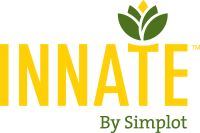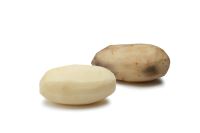 BOISE, Idaho – The J. R. Simplot Company today completed the food and feed safety consultation with the Food and Drug Administration (FDA) for its first generation of Innate potato varieties. The FDA concluded the Innate potato is as safe and nutritious as conventional potatoes.
BOISE, Idaho – The J. R. Simplot Company today completed the food and feed safety consultation with the Food and Drug Administration (FDA) for its first generation of Innate potato varieties. The FDA concluded the Innate potato is as safe and nutritious as conventional potatoes.
Simplot is working with growers and retailers to bring to the U.S. market several popular potato varieties with improved traits that benefit consumers, food producers and growers. Innate potatoes have fewer black spots from bruising, stay whiter longer when cut or peeled, and have lower levels of naturally-occurring asparagine, resulting in less acrylamide when cooked at high temperatures. Innate potatoes are also less prone to pressure bruising during storage, resulting in less potato waste and potentially millions of dollars in savings to growers every year.
Because the Innate potato provides significant benefits consumers want, including less bruising, less waste and more convenience, Simplot will recommend to growers and retail partners that they accurately promote and market these exclusive features on relevant packaging.
The FDA statement comes after the recent USDA deregulation of Innate potatoes. The FDA’s safety consultation on Innate potatoes was voluntarily requested by Simplot as a further evaluation of the Innate technology, which has been in development for more than a decade. These federal clearances involved years of technical review and a thorough public comment period that drew the support of 14 leading potato research universities in the U.S. and Europe.
“The Innate potato is the most promising advancement in the potato industry I’ve seen in my 30 years studying agriculture,” said David S. Douches, Ph.D., at the Michigan State University’s Department of Crop and Soil Sciences. Douches has implemented field trials of Innate. “This potato delivers significant health and sustainability benefits by using the potato’s own DNA. Such advancements haven’t been possible using traditional breeding.”
Simplot used the techniques of modern biotechnology to accelerate the traditional breeding process and introduce new traits by triggering the potato’s own RNA interference (RNAi) pathway. RNAi is a natural cellular process commonly used by plants and animals to modulate expression of certain genes and has been used effectively in multiple commercial crops sold over the last decade. “Unlike traditional methods of breeding, which introduce random mutations associated with dozens of genes, the method used to develop Innate potatoes is precise,” said Douches.
The three Innate varieties are expected to be available in limited quantities beginning in 2015 in the fresh and fresh-cut markets where the sustainability, higher quality and health benefits have significant value to growers and consumers.
A second generation of Innate potatoes, currently under review by the USDA and the U.S. Environmental Protection Agency, will offer two additional improvements to the potato, including increased resistance to late blight disease and better storability. These advantages are meant to create significant sustainability advances, such as reduced reliance on fungicides and fewer rejected potatoes.
 “The potato is an important and nutritious food staple, but is susceptible to damage when grown and stored,” said Haven Baker, vice president and general manager of Simplot Plant Sciences. “Innate has the potential to reduce post-harvest food waste and help meet the demand for better, more sustainable crops in the years ahead.”
“The potato is an important and nutritious food staple, but is susceptible to damage when grown and stored,” said Haven Baker, vice president and general manager of Simplot Plant Sciences. “Innate has the potential to reduce post-harvest food waste and help meet the demand for better, more sustainable crops in the years ahead.”